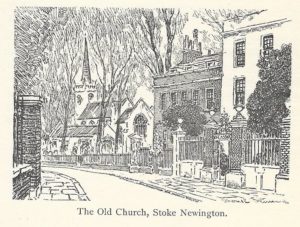Music can be a remedy in these times of danger and darkness, in its own peculiar ways. It can offer calm, consolation, and open new gates of perception. Readers of this interview with composer and drummer Sebastian Rochford may know well some albums of artists who did record in vast spaces, from the likes of Paul Horn, or Jan Garbarek moving into the monastery of St. Gerold. Thinking of albums that have been made outside the comfort zones of modern recording studios, clubs and concert halls, Pauline Oliveros‘ classic „Deep Listening“ may also come to mind, a quite thrilling exploration of natural reverb in a meditative state of mind. „Rose Golden Doorways“ by „Pulled By Magnets“ is somehow a wilder affair, and if anyone would ever write a book about wonderful albums, recorded in caves, churches, pyramids, and other power spots, the writer should make sure this album will be part of the journey.
FEELING THE SPACE, FILLING THE SPACE
Michael: If you are still living in London, what would be a great place for this interview if we would do it face to face. You have a favourite cafe there, or another place with a good vibe?
Sebastian: Would probably be the Colombian indoor market in Tottenham, I love that place and has great food and coffee, sadly it’s been sold off to make apartments so don’t know how long it’s going to be there.
Michael: My favourite Polar Bear album, „Same As You“, was inspired, in parts, by your visit at the Mojave Desert. Now, with the new trio in mind, what did you trigger to move into another vast space, The „Old Church“ in Stoke Newington?
Sebastian: This album was inspired by energy and creation, what it is that makes us and how our perception of that changes our lives. The church was for how I could further represent that sonically, I wanted us to have a place we could fill our sound into in an active way, where Pete could let his saxophone soar and somewhere that would answer back to the sound we were making.
Michael: The bigger the reverb, the less you have to play, or was it a challenge to approach the zone of falling apart, soundwise, meaning „conventionally“ soundwise?
Sebastian: I wanted to use the church in different ways, sometimes to feel the space and sometimes to fill that space with more volume and density, using the reverb almost as a sheet noise when needed.
Michael: If everybody in the band uses electronics to, at least from one perspective, alter the sound of the instruments, was the intention, to minimalize the expections associated with „nomal“ saxophone or electric bass sounds? Was the adding of electronics a device to further move into the unknown?
Sebastian: When we started rehearsing I asked Neil and Pete to have effects all the time and then we go from there, I wanted them to feel that extreme as a seed to grow from.
Michael: Did you record at nighttime? Apart from probably being in the zone while playing, how did the atmosphere of the church affect your mood? Was it more dark and brooding, or more on the peace of mind side of things? I‘m asking cause you can easily associate this music with archaic rituals, miles beyond the history of the place.
Sebastian: There’s a certain silence and acoustic in a church that for me, definitely has an influence on your mood, every sound is very much amplified, quieter sounds have such impact, so making lots of noise in there almost felt confrontational to what is perceived as the „right“ thing to do, this is in part of what the album is about, feeling energy as a whole and there being a balance in different elements. There was a passage I read in the Upanishads that said about human beings being a collection of armies that sometimes collide and sometimes work in harmony, this really made a connection with me and was an inspiration. Because of all the stained glass windows, the atmosphere changed during the day into night and I loved it’s presence and influence.
THE RIGHT TIME FOR A CHURCH BELL TO RING
Michael: Now there are, apart from drone elements, no playful allusions to Classical Indian music. The connection seems to come alive in a different way.
Sebastian: My Indian roots are always a part of my creativity as they are a part of who I am, but I did go back to India before making this album to connect again and see family. While I was there I didn’t listen to any recorded music, instead just listening to all the sounds around me, I felt I needed a sonic cleanse. As I write from singing inside me, I wanted to expand my internal sound and this was part of my process. I also studied singing while I was there though none of the Pulled by Magnets music uses any of the raags I learnt there. The Indian influence on this album was more my experience of going back there, my connection and the relationship I have with myself every day around it. My family there are all Catholic and I was brought up Catholic but I’m also descended from Hindus and in recent years was the first time I allowed myself to explore these religious traditions for myself, which I found great inspiration in and allowed me to think differently about who I am on a day to day basis, which in turn helped me to write and play this music.
Michael: Did you go into the church with some compositional sketches, and in the mood to see what happens when sound moves its special ways , or was it a more improvisational approach?
Sebastian: We went into the recording with written pieces and arrangements that contain passages of improvisation, the harmony in this music is very particular too, sometimes using 9 and 10 note scales that for me are integral to the sound of the music but as always I want to the musicians to take the music in their way when the ground has been set. I gave myself time before writing the music to daydream about form and sound in different ways.
Michael: The last piece of the album is building up to a climax, the sax, the noisy grid, but, in the end, a warm enveloping sound…
Sebastian: That’s me playing the church organ at the end and then the church bell which never chimed during a piece the whole time we were there, but went off ten minutes after we finished recording and I asked Sonny to record it. It felt like a natural way to rest the album.
Michael: Has there been a book that inspired the new album. Some discoveries you made by reading that opened you up for some of the „reasearch fields“ of this music?
Sebastian: I was reading alot The Upanishads, The Isvara Gita and The Mirror of Simple Souls which is essentially a book about Divine Love written by a French Bedhouin named Marguerite Porete who was burned at the Stake for refusing to keep her writings private, I discovered it through a great Dutch band called Turia. All these books greatly inspired me and enabled me to write this music as they gave me different ways to perceive the world and energies around us.
SYMBOLS, MAGNETS, AND FOOD
Michael: Opening the inner sleeve, you see an extension of the cover, a rather enigmatic drawing playing with symbols. Can you offer some information for those who might think they’ve found a treasure map?
Sebastian: From all the reading I was doing, I noticed there was an element of my intuitive understanding of these texts, so for the album I created symbolic and written text forms of the music that I hope people can feel and interpret using their intuition while listening to the music, every track has it’s own symbol that is personal to what it’s meaning is for me.
Michael: Why calling the trio „Pulled By Magnets“? There surely is a great alchemy between the three players, Pete Wareham again playing essentials, never entering the light talkative mood, and Neil Charles at the electric bass and electronics adding something wild, too?
Sebastian: I was describing the music to someone and they mentioned the feeling of being pulled by magnets, it stayed with me so I asked if I could use it which they said were happy for me to.
Michael: Have there been albums recently you have experienced as really immersive experiences?
Sebastian: For that experience I love the bands Solar Temple, Hexeth and Entheogen who I discovered after writing the music for Pulled by Magnets.
Michael: Did you do another ECM recording waiting for release?
Sebastian: No not as yet but I hope maybe in the future, Manfred Eicher is another great inspiration to me.
Michael: What are your plans for today or the day you have finshed to answer these questions? I do have some favourite rituals there, like traveling to the north by underground and strolling through Hampsread Heath. I always get into a very special mood there.
Sebastian: I started today with my own ritual and also watching two magpies gather twigs and mud for a nest.
Michael: What comes to your mind when you think of the late Jon Christensen on drums?
Sebastian: I saw Jon Christensen playing with Jakob Bro a few years ago, I loved watching him play, was at the same time like a master and curious child.
Michael: What has been recently, or way back, a TV series that put a spell on you in a good way, on Netflix or wherever, or did the „new revolution“ on TV did not cross your ways….
Sebastian: I love watching Netflix, so many good series, documentaries and food shows! I love watching programmes about food also because it is so connected to culture, history and community so you learn about all these things, one of my favourite ones is Ugly Delicious.

